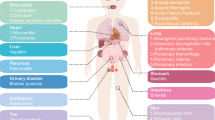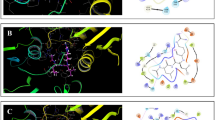Abstract
Since the advent of modern civilization, few diseases have caused more worldwide socioeconomic disruptions than COVID-19 caused by severe acute respiratory syndrome coronavirus-2 (SARS-CoV-2). In some countries, very high proportion of the population have contracted the disease even though it is fatal in only a small percentage of those carrying the virus. In addition to physical measures (social distancing, handwashing, sterilization, etc.), two main pharmaceutical interventions have been adopted: the development of vaccine/mass vaccination and therapeutic intervention. The recent discovery of SARS-CoV-2 transmission among vaccinated individuals and changes in the genome of the virus arising from mutation leading to new variants (delta, omicron, IHU etc.) suggest the importance of therapeutic intervention targeting different aspects of the molecular mechanisms involved in its virulence. Therapeutic agents targeting essential elements required for viral propagation in the host may also find application in the management of other viral diseases such as Ebola, Zika, and HIV/AIDS. Targets for drug design include the 16 non-structural proteins, RNA-dependent DNA polymerase, esterase, membrane proteins, spike and envelope proteins, protease and nucleocapsid proteins, and helicase, all present on the virus; host proteases and receptors. Both medicinal plant-derived and synthetic compounds including monoclonal antibodies are now suggested as candidate drugs for COVID-19 and are being developed as suitable therapeutic agents. In this review, some useful information on promising plant-derived therapeutic agents are provided which may be of value in the development of drugs for COVID-19 and other viral diseases.



Similar content being viewed by others
Data Availability
Not applicable.
References
Ludwig S, Zarbock A (2020) Coronaviruses and SARS-CoV-2: a brief overview. Anesth Analg 131:93–96
House NN, Palissery S, Sebastian H (2021) Corona viruses: a review on SARS, MERS and COVID-19. Microbiol Insights 14:11786361211002480
Singh TU, Parida S, Lingaraju MC, Kesavan M, Kumar D, Singh RK (2020) Drug repurposing approach to fight COVID-19. Pharmacol Rep 72:1479–1508
Yang Y, Islam MS, Wang J, Li Y, Chen X (2020) Traditional chinese medicine in the treatment of patients infected with 2019-New Coronavirus (SARS-CoV-2): a review and perspective. Int J Biol Sci 16:1708–1717
Hou W, Liu B, Xu H (2020) Celastrol: progresses in structure-modifications, structure-activity relationships, pharmacology and toxicology. Euro J Med Chem 189:112081
Khalili N, Karimi A, Moradi MT, Shirzad H (2018) In vitro immunomodulatory activity of celastrol against influenza A virus infection. Immunopharmacol Immunotoxicol 40:250–255
Fuzo CA, Martins RB, Fraga-Silva TF, Amstalden MK, De Leo TC, Souza JD, et al. (2021) Drug repurposing to face Covid-19: Celastrol, a potential leading drug capable of inhibiting SARS-CoV-2 replication and induced inflammation. bioRxiv 2021.
Ríos JL, Máñez S (2018) New pharmacological opportunities for betulinic acid. Planta Med 84:8–19
Fujioka T, Kashiwada Y, Kilkuskie RE, Cosentino LM, Ballas LM, Jiang JB et al (1994) Anti-AIDS agents, 11. Betulinic acid and platanic acid as anti-HIV principles from Syzigium claviflorum, and the anti-HIV activity of structurally related triterpenoids. J Nat Prod 57:243–247
Wen CC, Kuo YH, Jan JT, Liang PH, Wang SY, Liu HG et al (2007) Specific plant terpenoids and lignoids possess potent antiviral activities against severe acute respiratory syndrome coronavirus. J Med Chem 50:4087–4095
Zhang Q, Ye M (2009) Chemical analysis of the Chinese herbal medicine Gan-Cao (licorice). J Chromatogra A 1216:1954–1969
Cinatl J, Morgenstern B, Bauer G, Chandra P, Rabenau H, Doerr HW (2003) Glycyrrhizin, an active component of liquorice roots, and replication of SARS-associated coronavirus. Lancet 361:2045–2046
Ding H, Deng W, Ding L, Ye X, Yin S, Huang W (2020) Glycyrrhetinic acid and its derivatives as potential alternative medicine to relieve symptoms in nonhospitalized COVID-19 patients. J Med Virol 92:2200–2204
Letko M, Marzi A, Munster V (2020) Functional assessment of cell entry and receptor usage for SARS-CoV-2 and other lineage B betacoronaviruses. Nat Microbiol 5:562–569
Nguyen TT, Woo HJ, Kang HK, Nguyen VD, Kim YM, Kim DW et al (2012) Flavonoid-mediated inhibition of SARS coronavirus 3C-like protease expressed in Pichia pastoris. Biotech Lett 34:83–88
Solnier J, Fladerer JP (2021) Flavonoids: a complementary approach to conventional therapy of COVID-19? Phytochem Rev 20(4):773–795
Moore OA, Gao Y, Chen AY, Brittain R, Chen YC (2016) The extraction, anticancer effect, bioavailability, and nanotechnology of baicalin. J Nutr Med Diet Care 2:11
Chandra A, Chaudhary M, Qamar I, Singh N, Nain V (2022) In silico identification and validation of natural antiviral compounds as potential inhibitors of SARS-CoV-2 methyltransferase. J Biomol Struct Dynam 40(14):6534–6544
Udrea A, Mernea M, Buiu C, Avram S (2020) Scutellaria baicalensis flavones as potent drugs against acute respiratory injury during SARS-CoV-2 infection: structural biology approaches. Process 8:1468
Tsai YC, Lee CL, Yen HR, Chang YS, Lin YP, Huang SH et al (2020) Antiviral action of tryptanthrin isolated from Strobilanthes cusia leaf against human coronavirus NL63. Biomol 10:366
Wink M (2020) Potential of DNA intercalating alkaloids and other plant secondary metabolites against SARS-CoV-2 causing COVID-19. Divers 12:175
Wang M, Lin L, Lu JJ, Chen X (2021) Pharmacological review of isobavachalcone, a naturally occurring chalcone. Pharmacol Res 1(165):105483
Attia YA, Alagawany MM, Farag MR, Alkhatib FM, Khafaga AF, Abdel-Moneim AME et al (2020) Phytogenic products and phytochemicals as a candidate strategy to improve tolerance to coronavirus. Front Vet Sci 20:573159
**ao T, Cui M, Zheng C, Wang M, Sun R, Gao D et al (2021) Myricetin inhibits SARS-CoV-2 viral replication by targeting Mpro and ameliorates pulmonary inflammation. Front Pharmacol 12:1012
Funding
“This work was carried out under the COVID-19 Africa Rapid Grant Fund supported under the auspices of the Science Granting Councils Initiative in Sub-Saharan Africa (SGCI) and administered by South Africa’s National Research Foundation (NRF) in collaboration with Canada’s International Development Research Centre (IDRC), the Swedish International Development Cooperation Agency (Sida), South Africa’s Department of Science and Innovation (DSI), the Fonds de Recherche du Quebec (FRQ), the United Kingdom’s Department of International Development (DFID), United Kingdom Research and Innovation (UKRI) through the Newton Fund, and the SGCI participating councils across 15 countries in sub-Saharan Africa.”
Author information
Authors and Affiliations
Contributions
Isaac Olusanjo Adewale involved in conceptualization, validation, resources, supervision, funding acquisition, and writing—reviewing and editing. Oladoyin Grace Famutimi involved in investigation, data curation, visualization, formal analysis, and writing—original draft preparation. Oghenesivwe Osiebe involved in data curation, investigation, and writing.
Corresponding author
Ethics declarations
Conflict of interest
The authors declare no competing interests.
Ethical Approval
Not applicable.
Consent for Publication
Not applicable.
Additional information
Publisher’s Note
Springer Nature remains neutral with regard to jurisdictional claims in published maps and institutional affiliations.
Significance statement: This review highlights the therapeutic potential of plant-derived compounds for managing viral diseases, particularly human coronavirus diseases. These natural compounds target various aspects of the virus’s lifecycle and offer a promising alternative or complement to vaccines, especially in light of emerging variants and vaccine-resistant strains. Please let me know if any further information is required.
Rights and permissions
Springer Nature or its licensor (e.g. a society or other partner) holds exclusive rights to this article under a publishing agreement with the author(s) or other rightsholder(s); author self-archiving of the accepted manuscript version of this article is solely governed by the terms of such publishing agreement and applicable law.
About this article
Cite this article
Adewale, I.O., Famutimi, O.G. & Osiebe, O. Plant-Derived Compounds with Therapeutic Potential for the Treatment of Human Coronavirus Diseases. Proc. Natl. Acad. Sci., India, Sect. B Biol. Sci. (2024). https://doi.org/10.1007/s40011-024-01658-5
Received:
Revised:
Accepted:
Published:
DOI: https://doi.org/10.1007/s40011-024-01658-5




